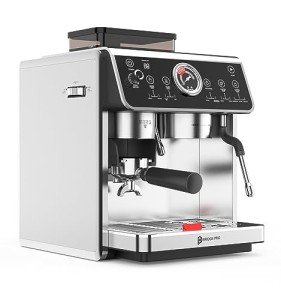The Art of Italian Espresso Machines: A Brewed Tradition
Italian espresso machines are not just appliances; they are an integral part of Italy's rich coffee culture, representing a mix of artistry, engineering, and style. Coffee fanatics all over the world acknowledge the value of high-quality espresso, a staple of Italian life and cuisine. This article checks out the history, mechanics, types, and elements to consider when purchasing an Italian espresso machine, showing the depth of this beloved drink and its developing approaches.
History of Espresso Machines
The espresso machine's evolution dates back to the early 20th century in Italy, where coffee was not simply a drink but an essential social ritual. The initial attempts to brew espresso begun with basic, stove-top models, slowly evolving into intricate machines that might reproduce the ideal brew.
- 1901-- The First Espresso Machine: The very first steam-powered espresso machine, understood as the "Ideale," was established by Luigi Bezzera. visit the following site marked a turning point in espresso developing.
- 1938-- The Lever Machine: The intro of the lever machine made it easier to control the pressure used in espresso extraction, enhancing flavor consistency.
- 1947-- The Automatic Machine: Reaching more customers, Gaggia introduced the very first automatic espresso machine, further popularizing espresso bars.
- 2007-- The Digital Age: Technological improvements resulted in the birth of completely programmable machines, permitting users to customize their developing settings to attain a personalized coffee experience.
Key Features of Italian Espresso Machines
Italian espresso machines embody accuracy, workmanship, and innovation. Here are some essential elements that highlight their significance:
| Feature | Description |
|---|---|
| Boiler Type | Figures out how heat is produced and maintained. Typical types consist of single boiler, dual boiler, and heat exchanger. |
| Group Heads | Where the coffee is brewed; commercial machines typically have numerous group heads for efficiency. |
| Pressure Control | Crucial for attaining the ideal espresso; most machines operate at 9 bars of pressure. |
| Frothing Capabilities | The steam wand enables milk frothing, necessary for drinks like cappuccino and latte. |
| Develop Quality | The products utilized (stainless-steel, brass, and so on) impact durability and heat retention. |
Types of Italian Espresso Machines
Picking the ideal machine hinges on user preferences, budget, and planned use. Below are the primary kinds of Italian espresso machines:
Manual Espresso Machines
- Pros: Offer full control over the developing procedure, enabling for a customized touch.
- Cons: Require ability and practice, can be labor-intensive.
Semi-Automatic Machines
- Pros: Provide a balance between automatic and manual procedures; users control water circulation.
- Cons: Can have a steeper knowing curve than completely automatic machines.
Fully Automatic Machines
- Pros: Simplify the developing process with push-button operations; ideal for novices.
- Cons: May compromise some of the subtleties of manual developing.
Super-Automatic Machines
- Pros: Grind, tamp, brew, and froth instantly; convenient for hectic way of lives.
- Cons: Less control over the developing variables, capacity for a less genuine espresso experience.
Buying Guide: Factors to Consider
Picking the perfect Italian espresso machine can be difficult, but thinking about the following elements can simplify the decision-making procedure:
- Budget: Italian espresso machines range from affordable to high-end designs, so set a budget upfront.
- Use Frequency: Evaluate how frequently you will use the machine; everyday users may desire a more long lasting option.
- Space: Measure your kitchen or counter area; some machines can be large and need sufficient clearance.
- Maintenance: Consider ease of cleansing; machines with detachable parts or integrated cleansing functions might reduce maintenance.
- User Skill Level: Beginners may prefer completely or semi-automatic machines, while experienced baristas can handle manual machines.
- Brand Reputation: Research brands understood for quality, such as Breville, Gaggia, and La Marzocco.
Popular Italian Espresso Machine Brands
Italian workmanship is renowned for producing a few of the very best espresso machines worldwide. Here are top brand names worth thinking about:
- Gaggia: Known for its home espresso machines and price.
- La Marzocco: A superior brand understood for its commercial-grade machines and innovative technology.
- Rancilio: Renowned for its resilient construct and professional-quality machines appropriate for home and commercial use.
- Sage/Breville: Offers advanced functions and user-friendly designs, best for both novices and lovers.
Frequently asked questions
What is the difference between espresso and routine coffee?
Espresso is a concentrated coffee brewed by requiring hot water through finely-ground coffee under pressure. It has a thicker consistency, richer taste, and higher caffeine concentration than regular coffee.
Can I make milk-based beverages with an espresso machine?
Yes, many Italian espresso machines come with a steam wand to froth milk for drinks like coffees, lattes, and macchiatos.
How typically should I clean my espresso machine?
Routine upkeep is important. Typically, a comprehensive cleaning is suggested every couple of weeks, while descaling should be done every 1 to 3 months, depending on water hardness.
What is the ideal pressure for brewing espresso?
The ideal pressure for developing espresso is around 9 bars. This pressure ensures the optimal extraction of flavors from the coffee grounds.
Are more expensive machines worth the financial investment?
Higher-end machines often utilize much better products and innovation, supplying enhanced resilience and more constant outcomes. For serious coffee enthusiasts, buying an excellent machine can raise the espresso experience considerably.
Italian espresso machines are far more than simple brewing devices; they are a celebration of a cultural custom that has influenced coffee usage worldwide. With various designs readily available to fit any user's needs-- varying from newbies to skilled baristas-- there is an Italian espresso machine perfectly suited for everyone. As you embark on your espresso journey, understanding the history, mechanics, and choices will enhance your experience and appreciation for this time-honored drink. Whether you seek to recreate a café ambiance at home or fine-tune your brewing method, these machines can delivering memorable cups of espresso decorated with the rich history of Italian coffee culture.

